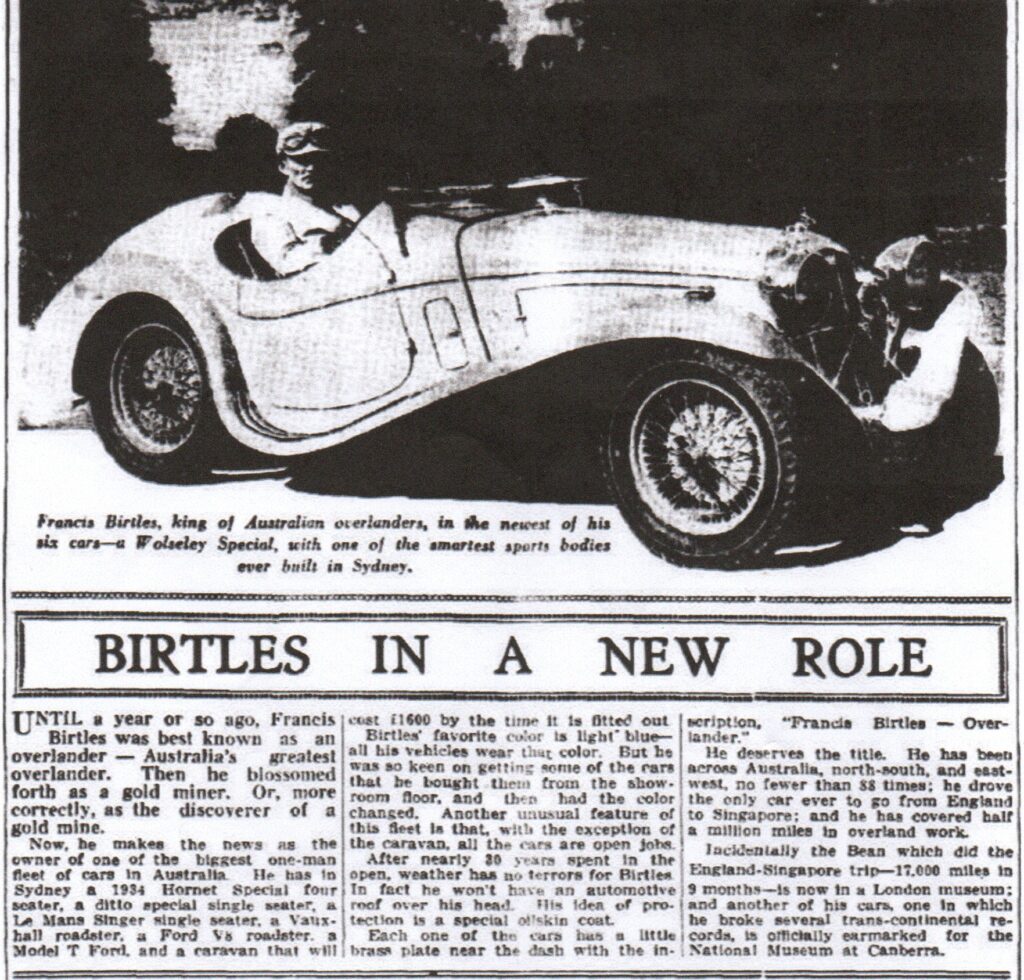History, Preparation and Background (See the Blog for the on-road reports)
The Greatest Drive
Recreation of Francis Birtles 1927 England to Australia Journey
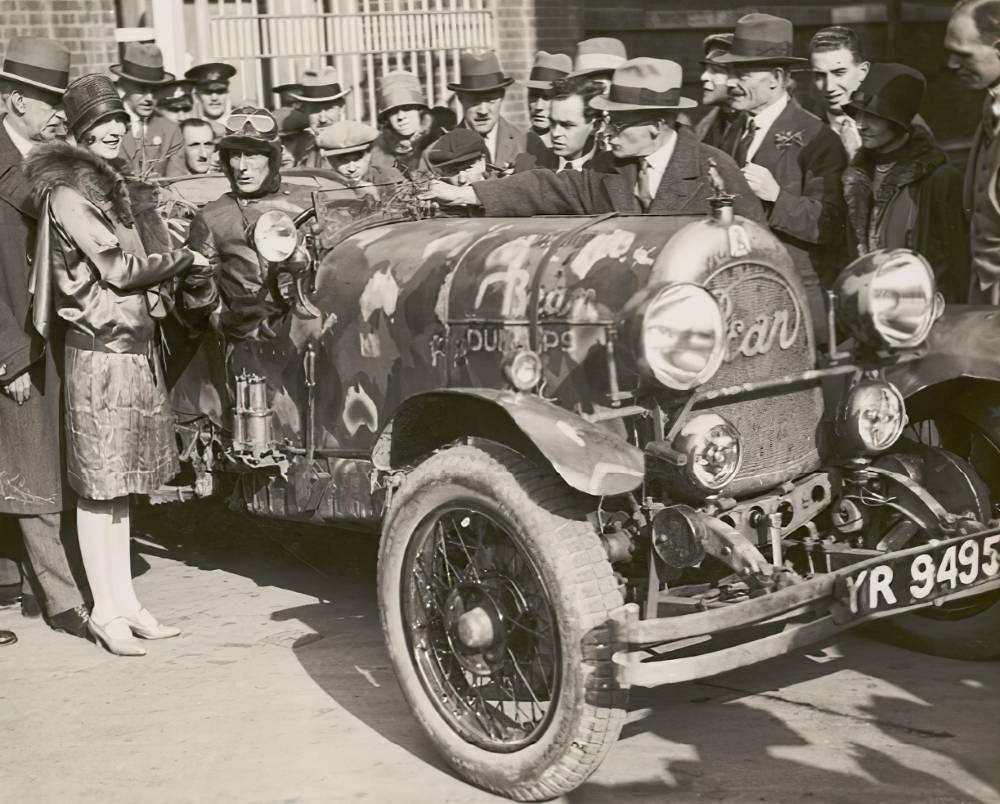
Miss Australia Phyllis Von Alwyn on left and aviator (centre no hat) Bert Hinkler .
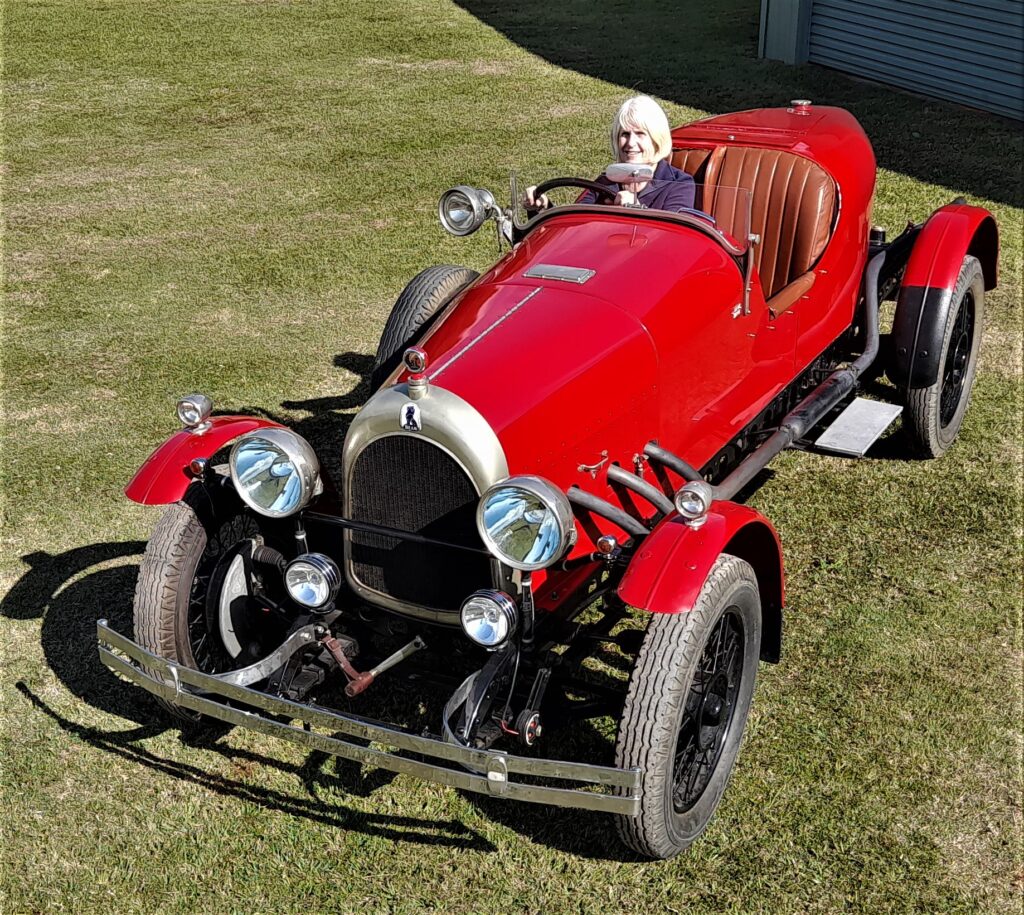
In the last weeks of April 2023 Lang informed me that there was a 1923 Bean car that he had long known of, displayed at Gilberts Motor Museum in Strathalbyn South Australia being advertised as part of a deceased estate. Ever since he was a boy Lang has followed the adventures of Australian Francis Birtles 1881-1941 and the availability of the car meant his brain was working overtime.
Birtles was an extraordinary adventurer who became the first person to drive a motor car overland, in an identical Bean, from London to Melbourne in 1927/28. Prior to WW1 his cross-country bicycle rides through the Australian deserts were legend. His motto being “Chance it”
Way back in 1936 Francis Birtles was at the height of his fame. Lang’s Dad, Richard, as a 16 year-old and his 14 year-old brother, Lester, inspired by their hero, undertook a huge 3,000km journey on their bikes from Melbourne to Home Hill (near Townsville) in Queensland. Dirt road all the way and it remains one of the greatest teenage rides to this day.
They had no money but in the 30’s every larger country town in Australia had a bike track and weekend events – usually with a bookmaker. The boys had an adult place a bet on them (how fit would they have been!) and they continued for two months on a starvation diet funded by their meagre winnings.
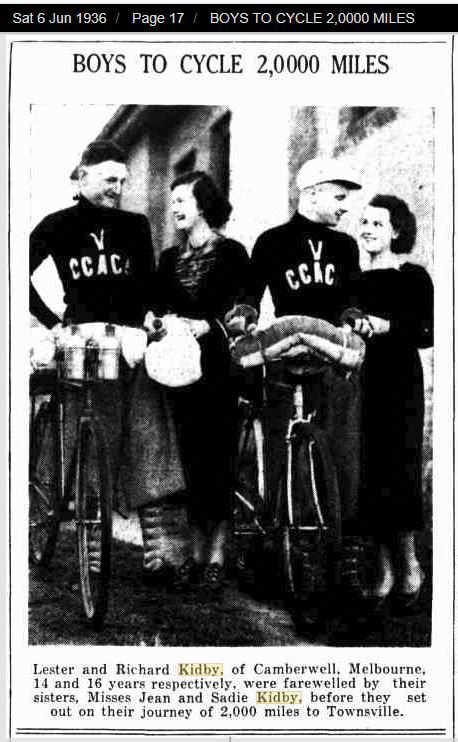
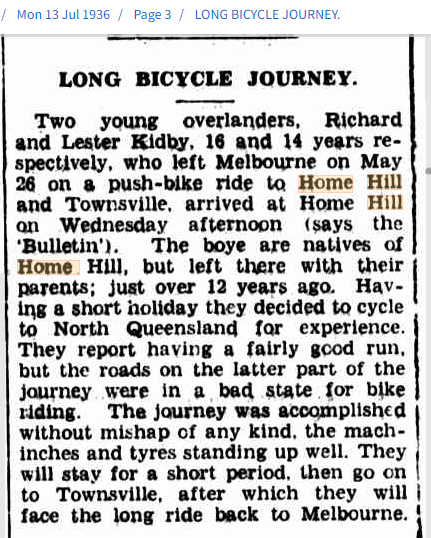
After returning from WW2 Richard entered the car business so Lang was brought up with Francis Birtles as the family Australian hero both as a bike rider and motorist.
Here are just some of Birtles” fantastic bike rides, mostly over horse tracks before 1920.
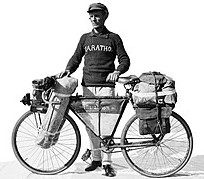
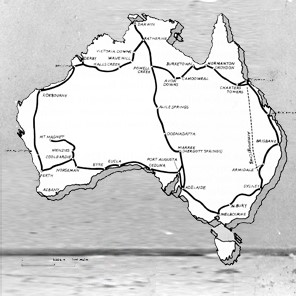
Lang remembers selecting Birtles for a school project on Australian pioneers in Grade 10 about 1962 and this Birtles Across the World recreation was the main reason for our North East India expedition in 2013 (see the story “Indian Expedition” on the website main page).
For various reasons this planned adventure did not come to fruition so Lang and Bev have grabbed the opportunity to make it happen.
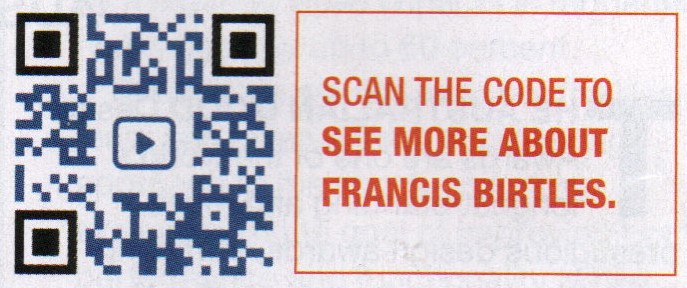
This is the chance to add another great historic recreation to our mission to bring to life the fantastic efforts of the world’s transport pioneers. Their trials, tribulations and often deaths are lost to society today. They opened up the world with heroic efforts in untested or unrefined technology. We owe them a great debt.
It is one of the most interesting of our historic recreations so far, which include:
The first flight from England to Australia in a replica 1919 Vickers Vimy – The Smith brothers 1919
The first solo flight from England to Australia in an original 1927 Avro Avian – Bert Hinkler 1927
Peking to Paris in a 1907 Itala (with all 5 original type vehicles) – Prince Borghese 1907
First to drive to Cape York in an original 1928 Austin 7 – Hector Macquarie and Dick Matthews 1928
After a motoring friend, Keith Thomson, inspected the car, with a very positive report, we went ahead and bought it sight unseen in early May 2023.
David Ragless, a spritely 88 year old, was more than happy to talk about his restoration and body construction of this close replica of Birtle’s 1927 car. The original is in the Australian National Museum in Canberra. David drove the car for a number of years often on long and rough journeys before selling it to the recently deceased owner, the well known South Australian collector, David Read.
In the intervening weeks Lang has been non stop brain storming and working on possible routes, shipping, and generally how we can structure the whole trip.
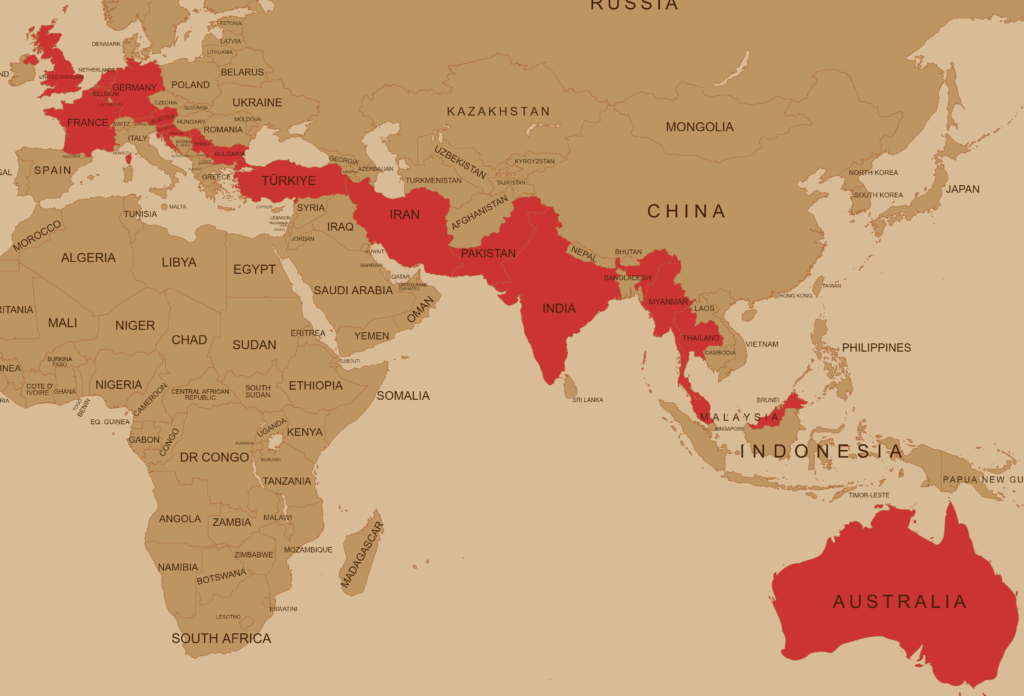
Naturally the expedition needs to be funded and we believe we can offer great things for supporters. We would love to talk to any potential sponsors.
Two of our journalist friends have also been keen Birtles fans.
Ron Moon has a great article on Birtles’ life on his web site https://www.dirtroaddiaries.com.au/historic-motoring/francis-birtles/
Our partner in the Peking to Paris race, Warren Brown, not only owns another BEAN replica but he has written an excellent book on our hero. It is an entertaining read.
Francis Birtles – Australian Adventurer by Warren Brown – Hachette Australia
Also in 2019 Terry G Birtles wrote “Driven” – Francis Edwin Birtles Trans-Australian Overlander, Cinematographer & Writer
26 May 2023
We have just received the photos of the car being loaded onto a trailer at the museum on its way to its new home in Brisbane and proposed further adventures.
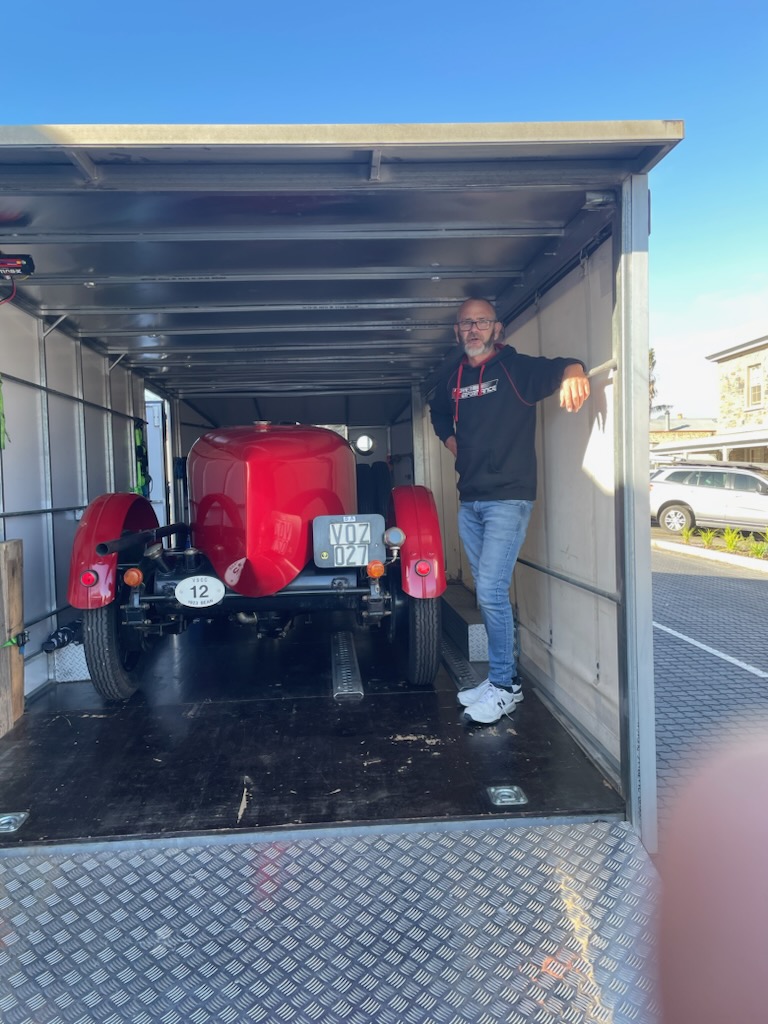
27 May 2023
Interest in the project is now coming from many quarters.
Of course our great friend, Ravi Kumar, Chairperson of the Calcutta Motor Sport Club, has hit the ground running and is doing his usual grand job with advice and introductions.
The most promising result so far has been Ravi’s introduction to well-known classic motoring journalist Gautam Sen in Paris. You can see Gautam’s work on the fabulous on-line magazine https://magazine.derivaz-ives.com/ Gautam is our FIVA connection.
FIVA (Federation Internationale des Vehicules Anciens) is the sister peak motoring body to FIA which oversees Formula One and International Rallies. FIVA looks after concours, rallies and major events involving vintage, veteran and classic cars. They have taken us on as an international project for 2024.
Here is a nice little clip on what FIVA are all about
Gautam has contacted his FIVA associates along the route and in just a few days Ramin Salehkhou in Iran has enthusiastically joined the fray and is working to give us a great journey through his country with the support of the old car members along the way.
4 June 2023
The Bean finally arrived and unusually, looks far better in real life than the photos. David Ragless’ restoration of 25 years ago really was a superior mechanical and body result (I strongly suspect the workmanship is far superior to that to be found on the original car). The restoration was a serious undertaking and no “modernising” took place. Several other BEAN owners donated original parts and those unobtainable replacements were manufactured to original specification from factory drawings, manuals and photos.
Of huge assistance was the presence of Francis Birtle’s original car in a nearby South Australian museum before it was transferred to the Australian National Museum in Canberra. David described the many hours he spent back in the 80’s with a camera and tape-measure in the museum with Birtle’s original “Sundowner” to produce the closest copy possible.
David had it finished in time to drive from Adelaide to Canberra to be a feature in the 1988 Bicentennial National Rally.
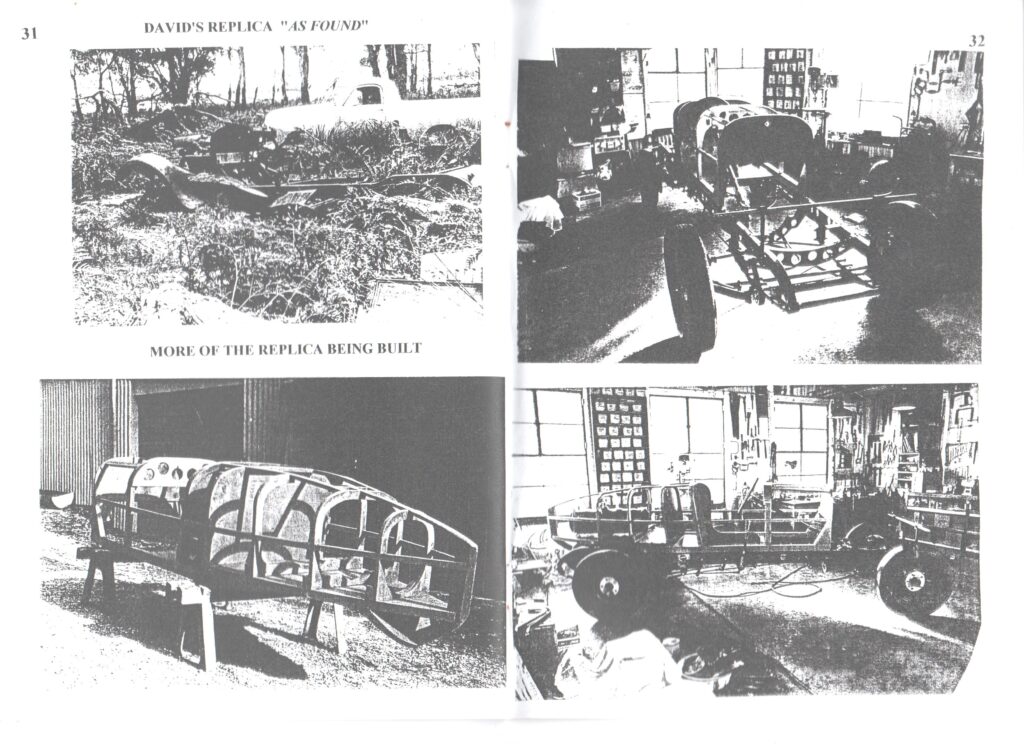
Birtles carried extra fuel and David Ragless who rallied the car on some long distance drives fitted a period style long range tank in the rear compartment. This should give the Bean a range approaching 1,000km, far more than required on any leg of the journey. There is a fuel tap beside the cockpit to allow switching tanks while on the move.
I have commenced adding to the “Sundowner 24’s” additional equipment from photos of the car early in its 1927 journey. Later photos, if carefully studied, show the Bean shed much of its original self on the hard drive across the world. Mudguards, bumper bar, engine side panels and several minor parts probably still are laying in the deserts or jungles alongside Birtle’s path.
Birtles had a large cockatoo mascot in front of the windscreen in only one of the London departure photos but it was never seen again on photos of the Sundowner along the way. It mysteriously reappeared in a photo from Blackall, outback Queensland, on his journey home. Did he carry it with him or was it posted home to collect on his arrival in Australia?
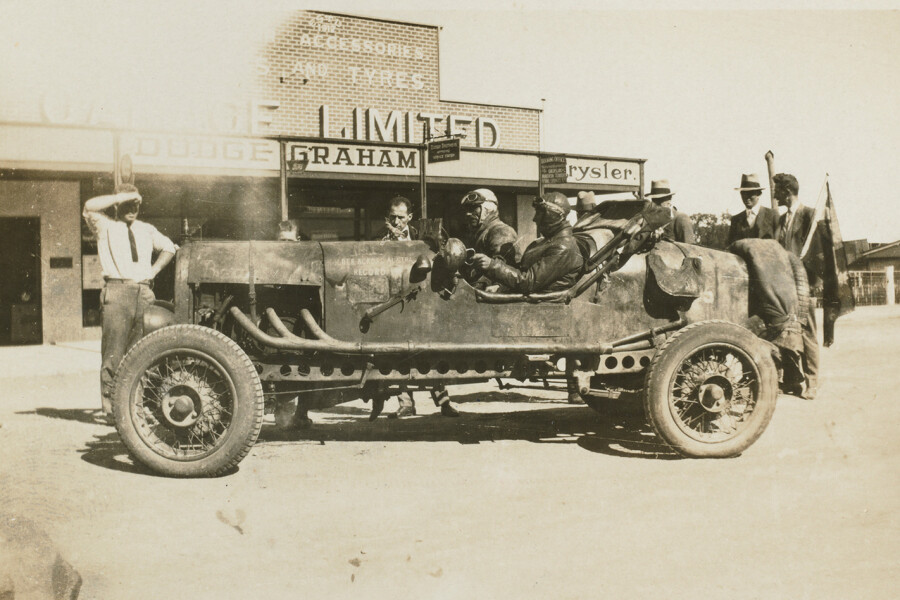
He must have liked it because it reappeared in the early 30’s attached to his Vauxhall Hurlingham on later trips (see below).
Birtles’ kangaroo radiator mascot sits sideways. I wondered why, until lifting the engine cover broke the tail on my similar kangaroo. My kangaroo will just be for show because on the road the radiator cap will carry a very common period Boyce MotoMeter temperature gauge (a thermometer down into the water) to allow me to keep track of engine overheating.
To date I have fitted period spotlights to match the originals and reshaped a vintage bumper bar to replicate the 1927 Bean style. Toolbox, jack and an original Dead Ezi tyre pump have been mounted.
A folding roof from a 1925 vehicle is being modified to match Birtles design to fit the “Sundowner 24”. The main change is reducing the top bows from an originally cosy width of 4′ 6″ (you can not use metric measurements on a 1923 British car) to a very squeezy 3′ wide.
The cockpit seating is styled on the two-man racing cars of the period where the mechanic’s seat is a few inches back from the drivers. This allows their shoulders to overlap and gives the driver full freedom to swing the large steering wheels of the time. It is still very “cosy”.
Identical period Lucas sidelights have been fitted with orange bulbs to provide the compulsory modern turn signals. As a sensible nod to modern safety awareness seat belts are being fitted.
Below are photos in Brisbane with preparation underway.
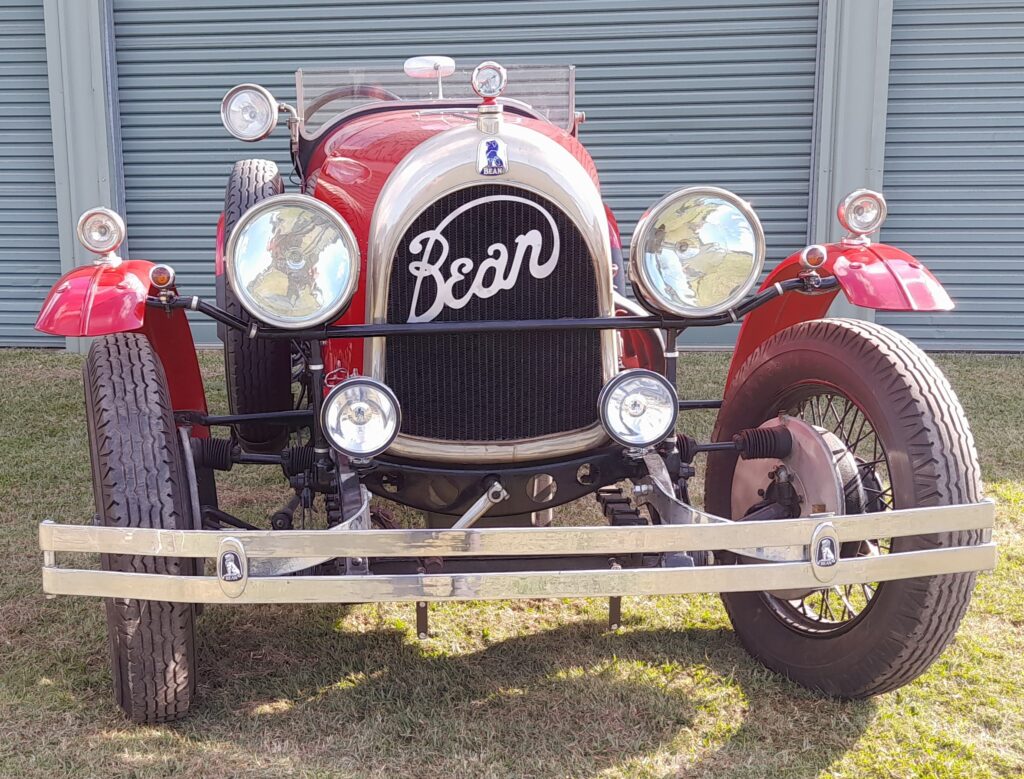
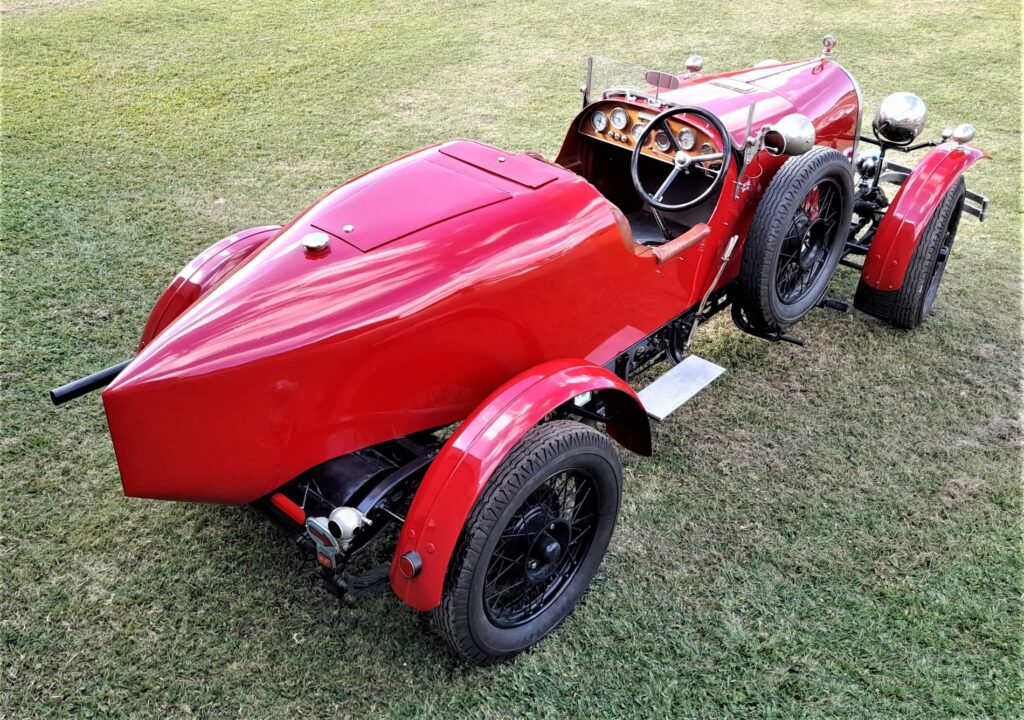
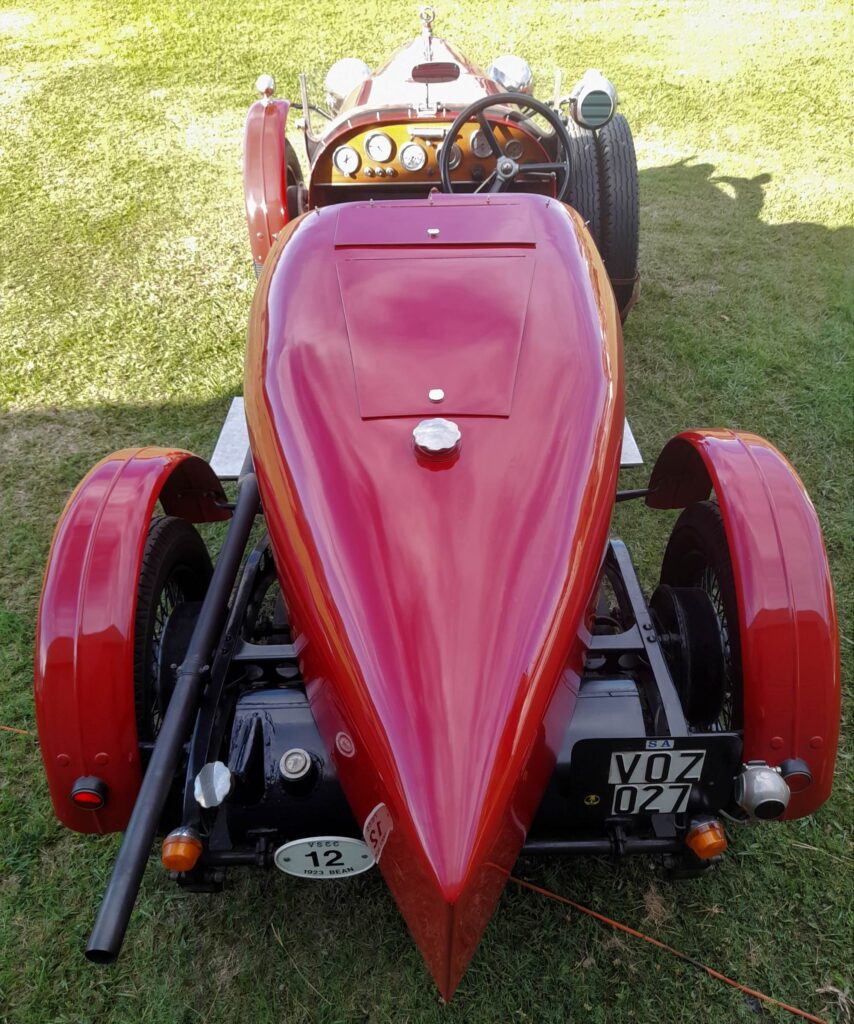
Francis Birtles adventures in the Bean 14 “Sundowner”
1926
All in the Bean 14 “Sundowner”
Melbourne – Darwin Transcontinental record 4,200km (this was Birtle’s 14 th transcontinental adventure in many different makes of car)
Darwin – Sydney record (6 days) 4,000km
Sydney-Melbourne record (1 day) 720km
Darwin-Melbourne record (5 days) 4,720km (His second Darwin trip for the year)
1927
Birtles first attempt to drive London to Australia 20 February with Malcolm Ellis in an experimental BEAN 6 car. They reached as far as Delhi in India before the car completely collapsed into “scrap metal”
He immediately telegraphed for his old faithful BEAN 14 “Sundowner” still covered in Australian outback dust to be readied and left London a second time 19 October. He arrived in Melbourne 25 July 1928. A crowd of 10,000 blocked the street to welcome him.
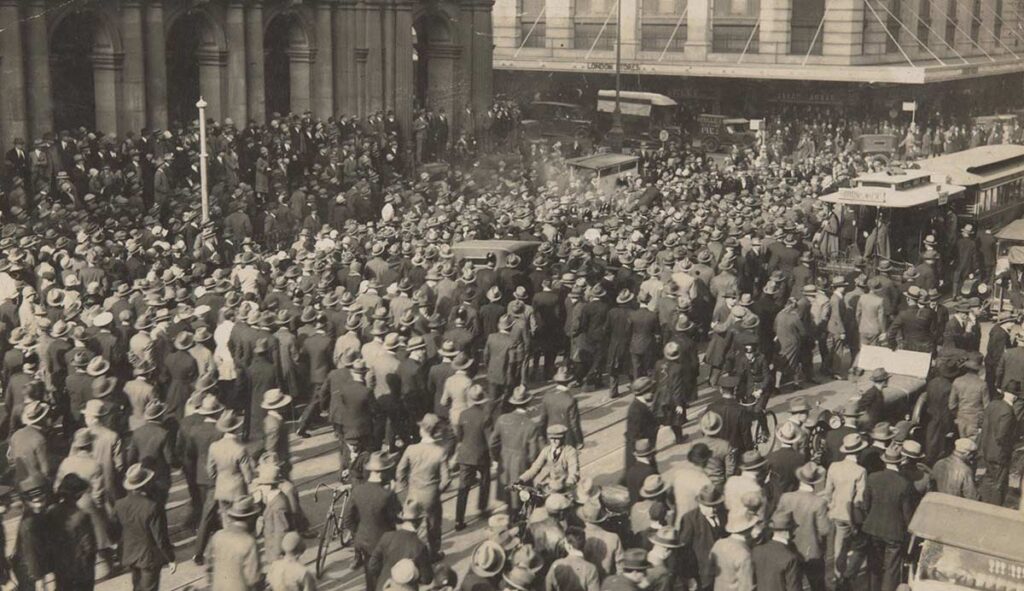
1928
“Sundowner” was presented to the Australian National Museum (which did not exist at the time) and it was pushed from shed to shed for the next 40 years. Each time more and more of the car was removed by souvenir hunters. It was restored from its very sad condition in the 1960’s to running order and is now displayed at the Australian National Museum (which now exists – in Canberra)
Birtles was immediately given a new replacement Bean 14 and continued his record breaking and outback exploration drives in it and many other types until his death in 1941.
The battered “Sundowner” in the Australian National Museum, Canberra.
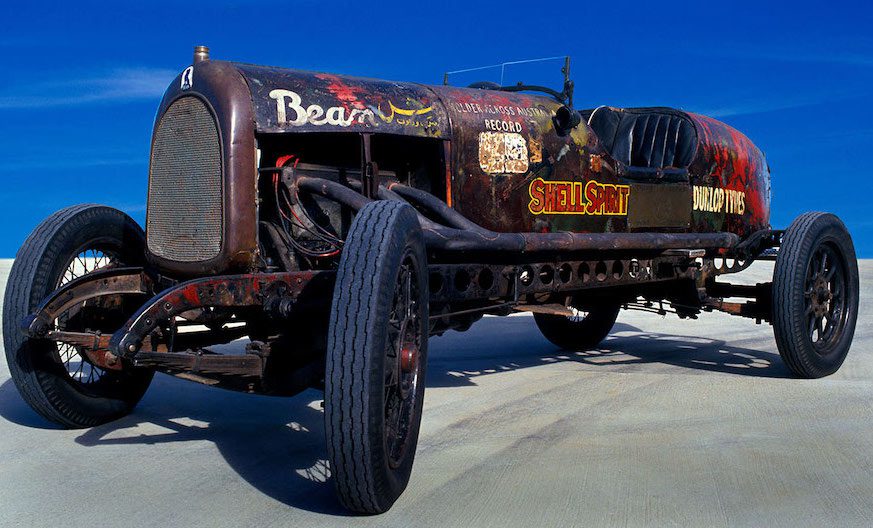
22 June
This week we attended Dick Smith’s annual Old Adventurers Club lunch. It was encouraging to get so much interest and support from Australia’s most famous and accomplished adventurers.
Dick, as usual, is following our latest expedition and is encouraging us on our preparations.
When Birtles did the drive his engine was only a couple of years old while our engine is over 100 years old. There are large amounts of alloy in its construction which becomes brittle and stressed over the years. I am investigating fitting a compact overdrive unit in the tail-shaft to lower the engine speed, will certainly go a long way towards successfully covering 20,000km.
15 July
We just had a visit from 13 year old Besnappy. He is a budding documentary maker and he came from his farm in the Hunter Valley with his dad to Brisbane to shoot a segment on our trip. His parents do not want him to use his real name until he is a little older.
Bev and I think he did a great job producing a YouTube video, aimed a young people, and reviving Francis Birtles’ name as Australia’s greatest overlander.
Here is the Link
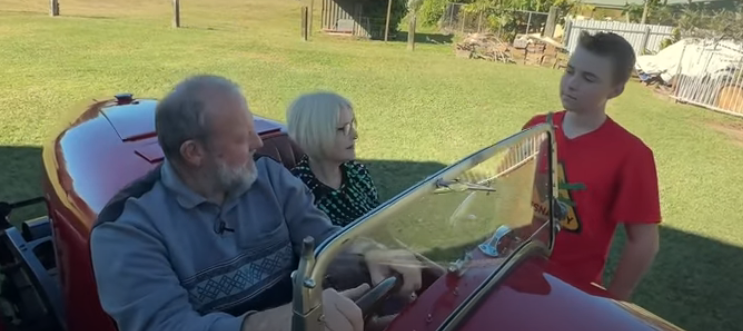
12 August 23
Work is proceeding apace on the Bean. We are finding many problems with a vehicle sitting in a museum for years without going on a decent drive. Lots of seals are leaking and need to be replaced, a couple of bearings, although almost new, have to be replaced because of pitting.
When first started, the engine was exceedingly noisy and only running on 3 cylinders. We eliminated a lot of noise by adjusting the main drive chain and giving it time to warm up and loosen the frozen links. The exhaust valve on #1 cylinder was frozen open so a night soaked in WD40 was prescribed.
Next morning it was no better so, after taking a plug out, the valve was driven down with a broom handle but upon starting it just stuck again. Not wanting to lift the head I decided to help the system by holding the broom handle on top of the valve and running the motor. A few blisters later from the bouncing handle and the valve freed up sufficiently for the valve springs to carry on alone doing their job of closing the valve.
Often brought up in discussion is how Birtles managed to use his folding roof. It must have been of importance to him as one would think it would be the first thing to go before the eventually jettisoned bumpers, mudguards and engine side panels. Obviously his low windscreen did not allow the normal 1920’s top attachment so he could only have the roof up at very low speeds or it would have been a parachute. It would appear it was only for shade in low speed track situations (of which he had many).
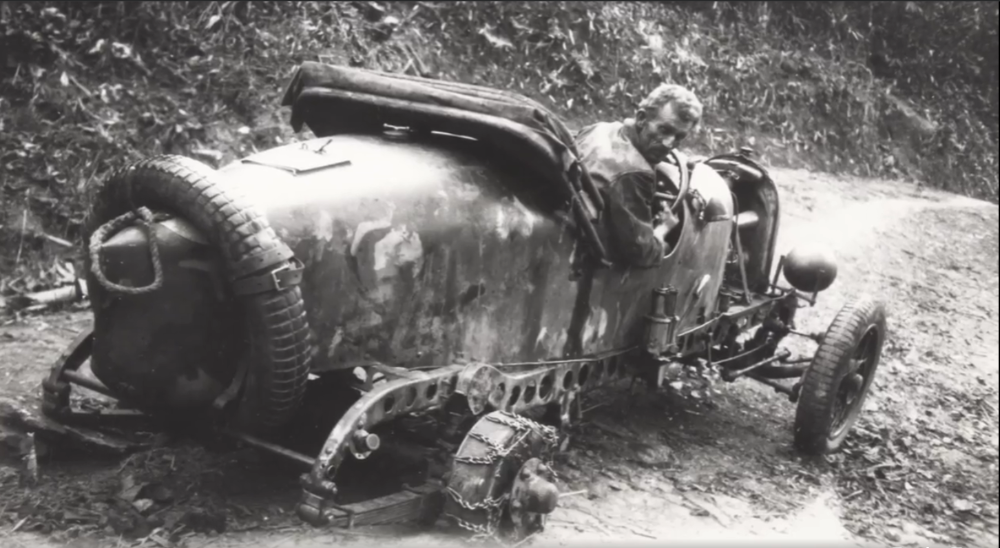
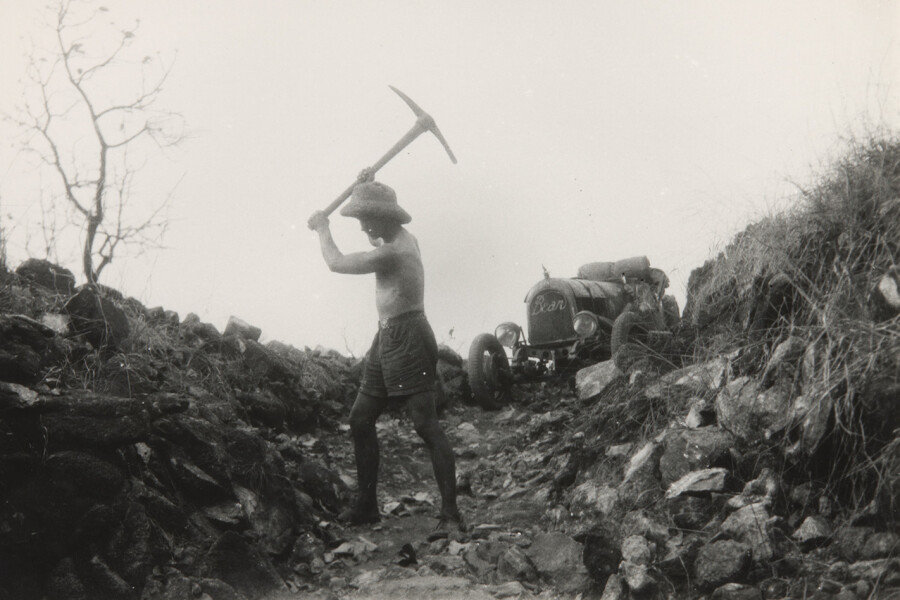
Birtles battles his way through the Naga Hills between India and Burma. 60 days to cut a road 68 miles long. His solution for steep hills: Reverse the crown-wheel in the differential to give him only one super-low gear. Remove the rear wheels, cut grooves in the brake drum and wire chains to the hubs to get traction on the near-vertical jungle track. Birtles and his mate, Percy Stollery (who was a Canadian hitch-hiker he picked up in Calcutta) nearly died from malaria and malnutrition during this heroic task.
Being somewhat older than Birtles we decided that the roof should be useful in all circumstances so I duplicated the bottom half of the sports windscreen and made a full conventional screen to support the top in accordance with standard practice of the time. The “pins” on top of the screen are the roof attachment points. The added section is just bolted so it can be returned to “sports mode” in 15 minutes. I went for acrylic instead of glass because not only is it clearer than glass but so strong a thrown brick will not break it. Scratches can just be polished out like a similar acrylic aircraft windscreen.
We have been very pleased by the comments from visitors that the revised screen makes the car look much better and more balanced. The hand cranked windscreen wiper was a popular after-market extra of the time. This one is from a WW2 Willys Jeep.
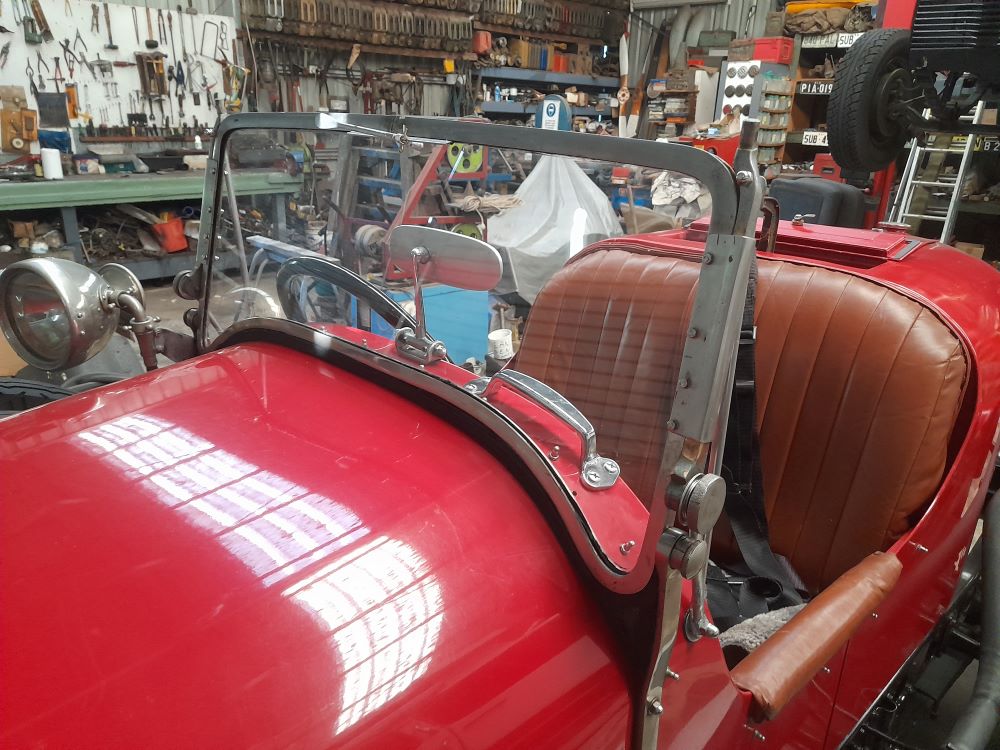
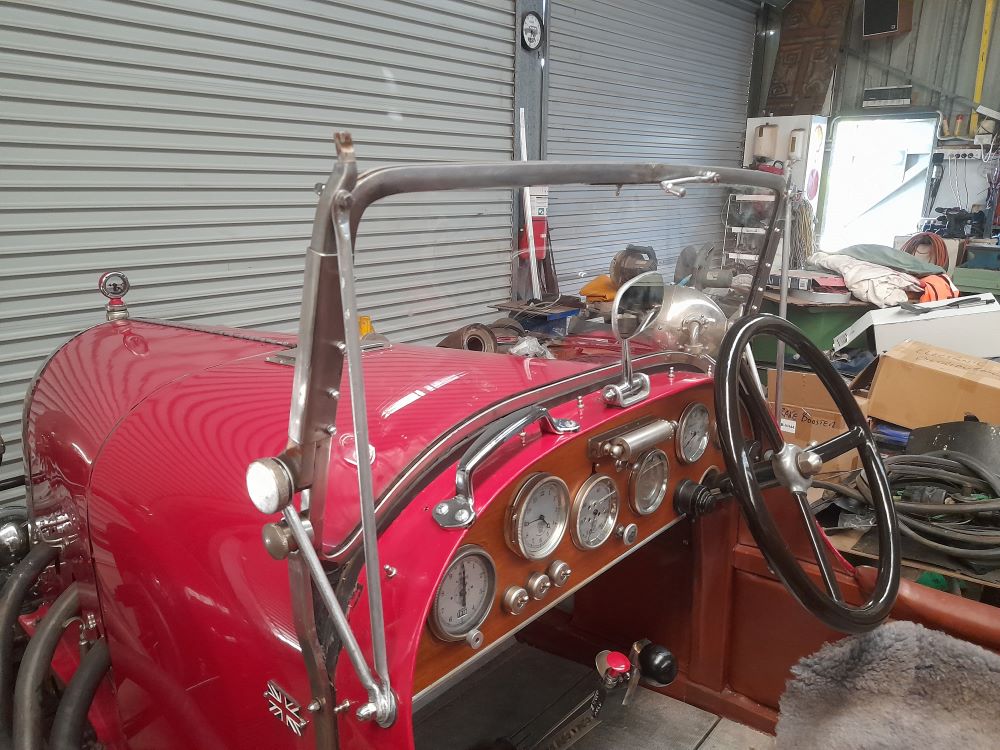
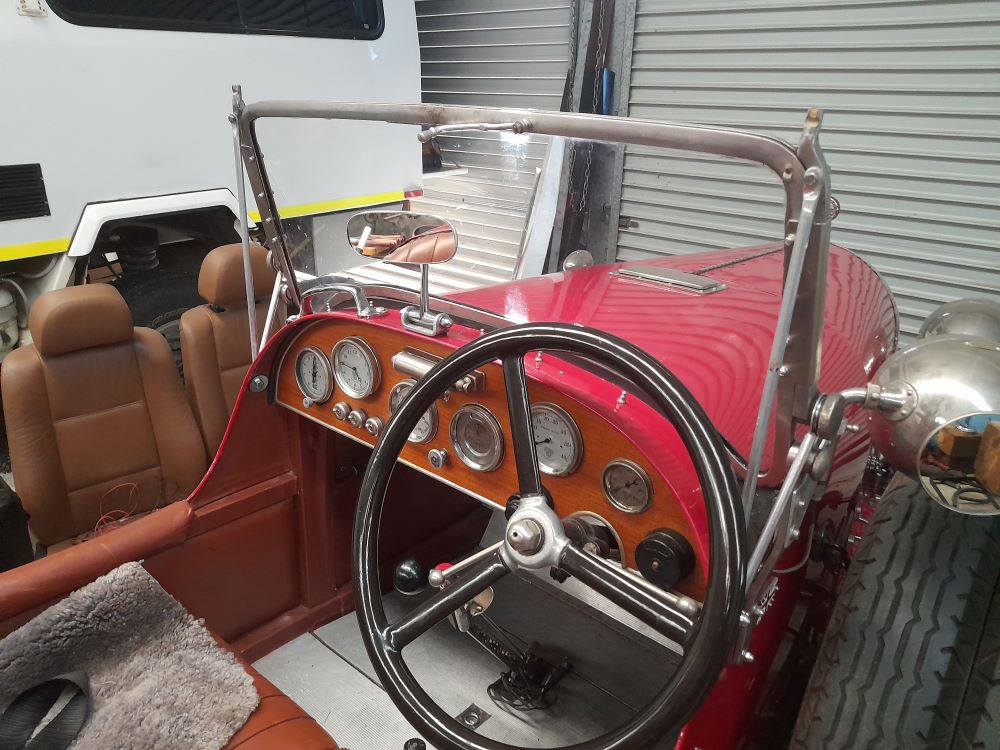
Panel Layout.
From left to right. Altimeter, Clock, Speedometer, Ammeter with light switch ring on outside, Dash light above, Tachometer. Oil Pressure (behind wheel). Switches – Generator cut-out, Magneto Ignition, Coil Ignition, Pull-type starter switch, Choke above, Horn button headlight dip combined. Turn signal (behind wheel), Spotlight switch (behind wheel). Silver lever on gearstick is reverse safety (will not allow you to accidently go through the gate into reverse).
August 30
The RACQ (Royal Automobile Club of Queensland) “Road Ahead” magazine has just done a story for its 1.8 million subscribers.
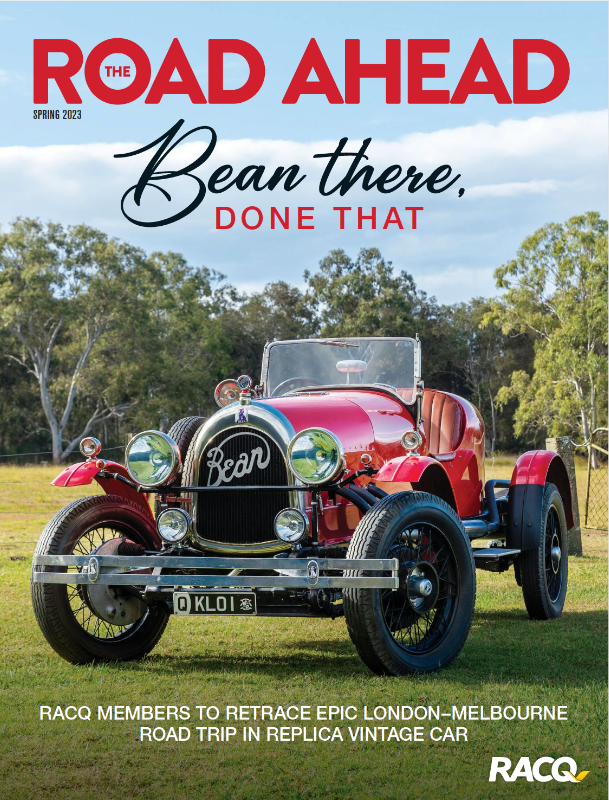
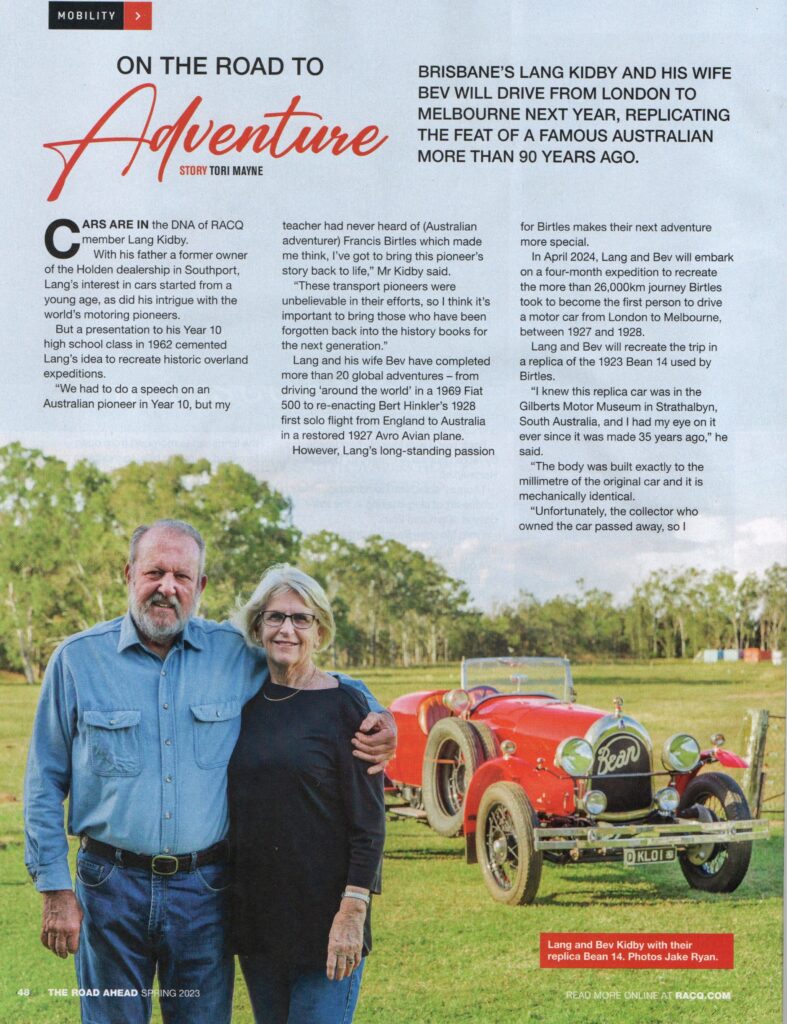
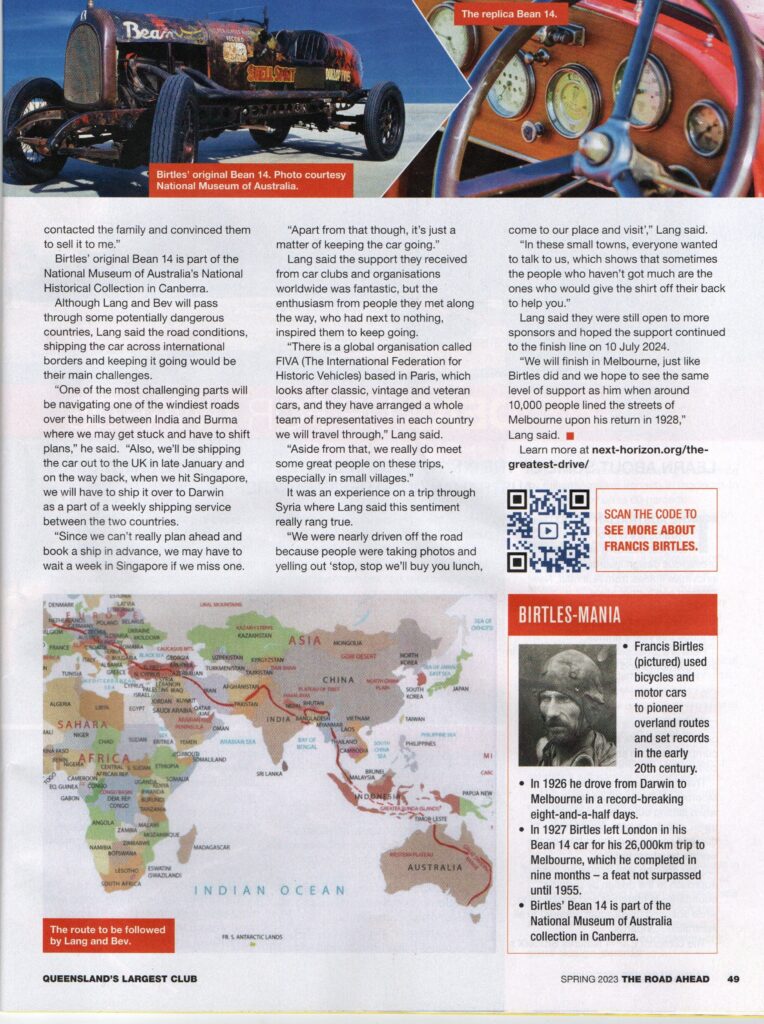
20 September 2023
Lots of activity taking place regarding shipping, routes and events.
Ravi in Kolkata is finding lots of shipping options through his contacts and we are looking at the best on offer.
The FIVA contacts are really getting behind the trip.
Ramin in Iran has his team well under way and has produced daily running maps to give us the most interesting journey through the country. The team expects to meet us at the Turkish border and guide us through to the Pakistan border a week later.
Mohsin in Pakistan has also produced daily maps and has a team to hand over from Ramin’s people at the border and has planned a very good route through to the only Pakistan/India border crossing in the north near Lahore. As this is around the half-way mark he has planned a one or two day layover for a full service and maintenance on the Bean
We also had our first outing to the Brisbane “All-British Day”. There were several hundred vehicles and the Bean was well received.
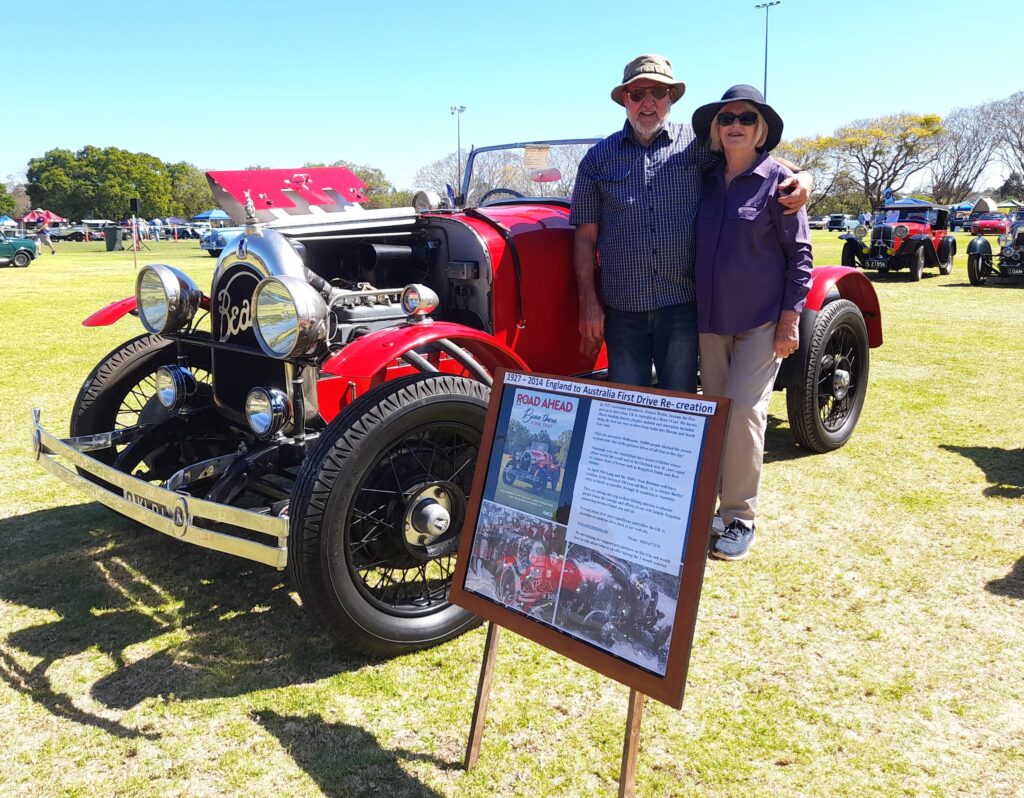
30 October 2023
We have just returned from visiting Francis Birtles’ only known original car apart from the “Sundowner” in the museum.
Bruce Barton has the Vauxhall Hurlingham that Birtles used to do his explorations in Arnhem Land in the early 30’s. It is a very upmarket vehicle and has never been restored. Bruce says it has been in his family for 60 years and he drives it several times a week. It was nice to see the Vauxhall and the Bean together cruising along as we went for lunch near Noosa.
After returning from the bush, Birtles found the factory body was very cramped (see newspaper clipping) so he had body builders cut the door away and reverse its position to allow full freedom of movement. This unique modification can be seen in the wedding photos with his new bride, Nea, in 1935.
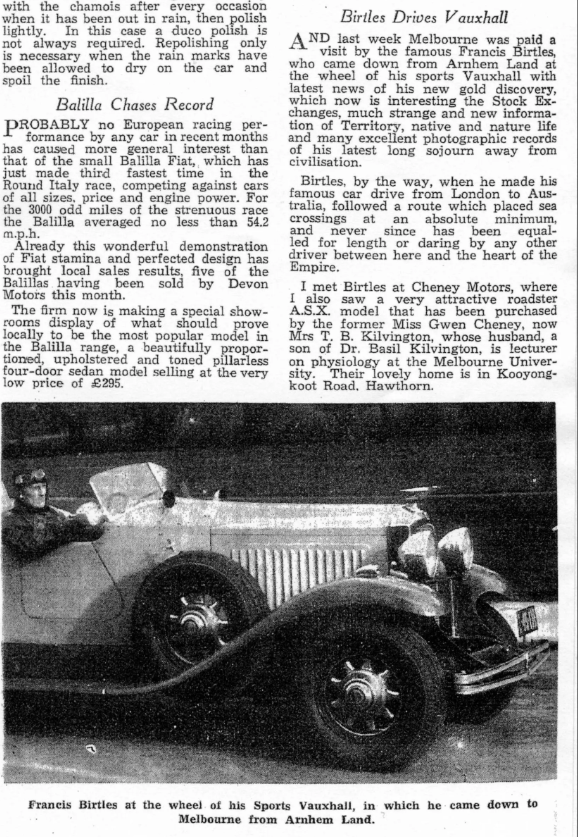
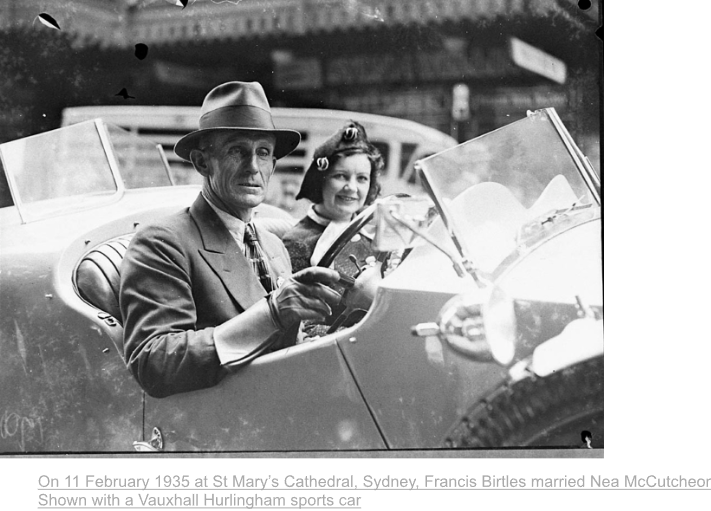
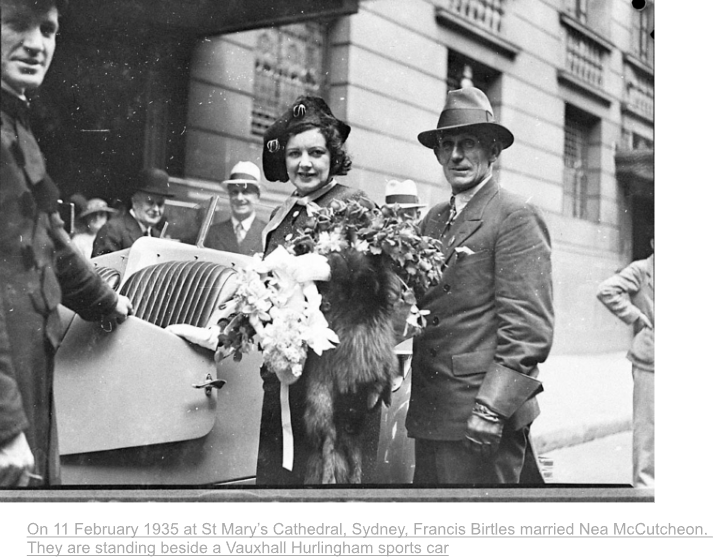
Bruce Barton and his ex-Birtles Vauxhall Hurlingham. Note the missing Cockatoo from 1927 has reappeared on the Vauxhall.
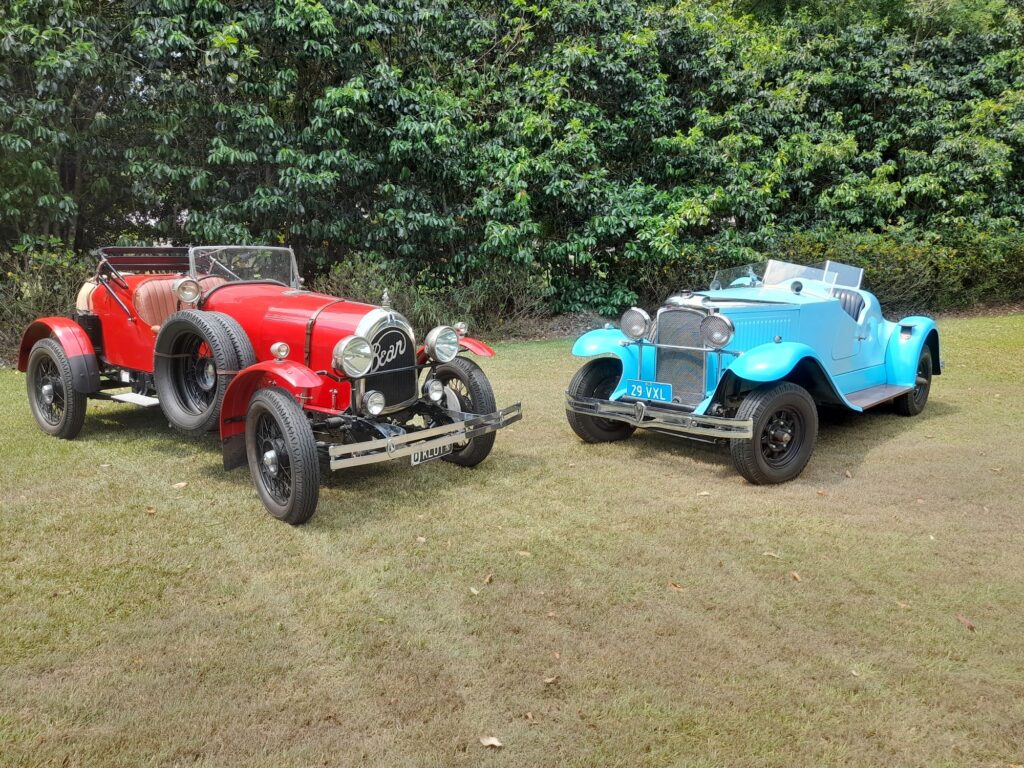
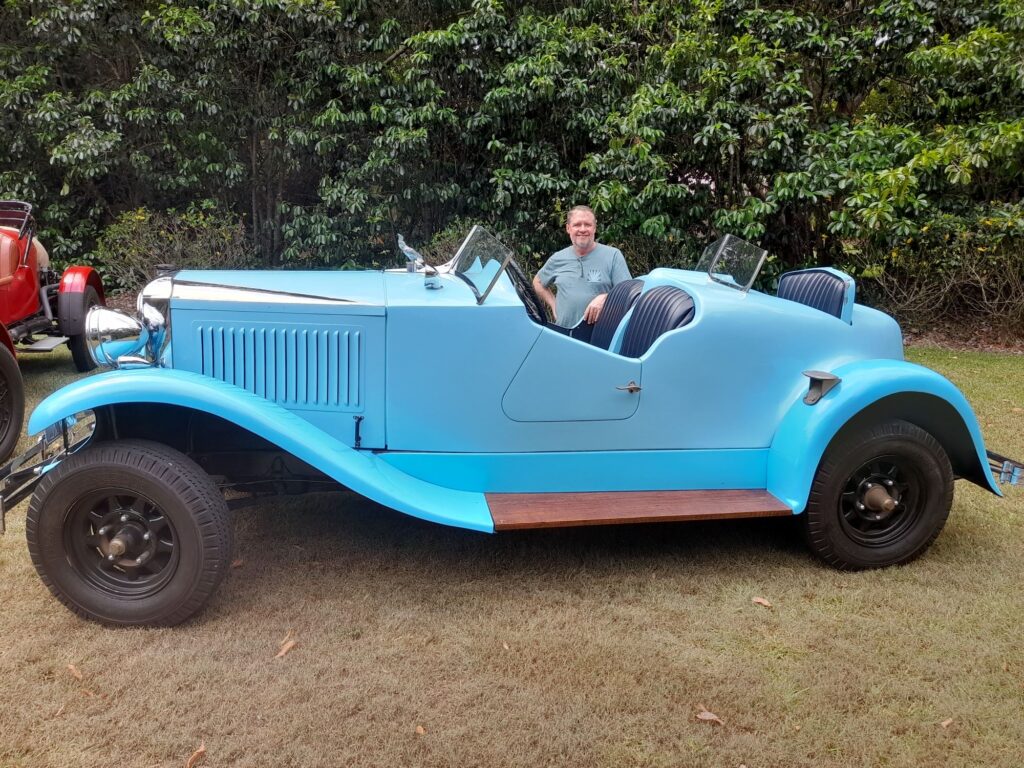
The Bean and the Vauxhall. A nice comparison of British styling between early 20’s and early 30’s.
15 November 2023
We finally have the Birtles style top fitted. Amazingly access is possible with it up and it gives great shade without flapping.
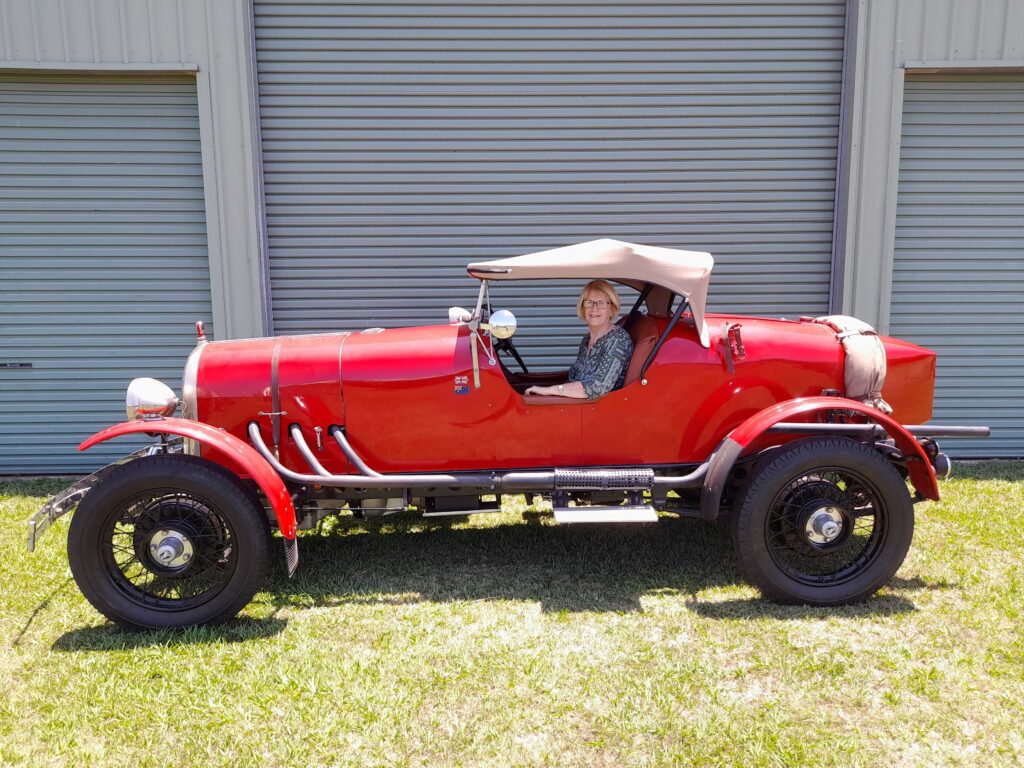
Also this week Anthony gave me a hand to pull the head off and do a full top-end service with a valve grind and new head gasket. As to be expected it had a lot of carbon in the cylinders from its 30,000km of previous running and the valve seats were a bit rough. It runs very sweetly now.
We had no trouble reaching 100kmh on a 40 minute each way run to Caboolture on the freeway but the car is much more comfortable at our intended cruising speed of 80kmh. A hot day and the top will certainly be up most of the time.
We have started the bureaucracy battle to enter with a car to travel through 16 different countries. At this stage Australia (paper to leave and more paper to come back) is neck and neck with India as leaders in the paper war. Australian costs and charges are at least double any other country.
26 November 2023
Some more good news today from David Thomson of the Malaysia & Singapore Vintage Car Register the local FIVA representative. He has joined the fray.
We now have been adopted by all the national historic car organisations through FIVA all the way from the UK, through Europe, Turkey, Iran, Pakistan, India, Malaysia and Singapore. Experience has shown local assistance along the way is worth more than any amount of preplanning.
The most important thing is the FIVA connection will ensure we get to meet and genuinely interact on a personal level with hundreds, if not thousands, of people along the way. Press releases and media interviews get the word out but there is nothing to compare with one-on-one contact for enjoyment.
Our latest club magazine.
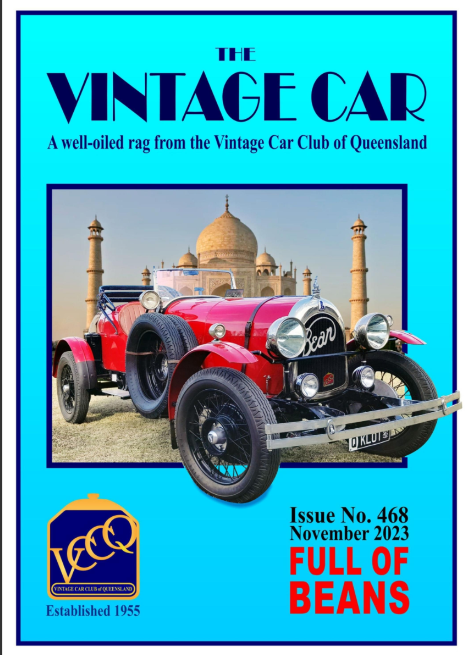
2 December 2023
The car is now booked on a ship to the UK departing next month. This is co-ordinated with our departure from London on 01 April 2024.
We have not decided on our London departure point. On 19 October 1927 Francis was flagged off from the Olympia Motor Show after Sir Harry Brittain had ceremonially recorded the numbers on his Dunlop tyres and numerous speeches. Birtles then drove a couple of miles to Australia House in the Strand for the usual PR dog-and-pony show – see photo above. After more speeches and photos he departed for the Folkestone ferry
Detailed trip planning including projected development of military unpleasantness, allowances for delays of numerous possibility and breakdown comes up with around 300 hours of actual driving over around 60 days of movement. A wishful arrival date in Melbourne may be 04 July 2024 – but who knows? Naturally the closer we get, the firmer the date will be.
11 December 2023
Ten years after David Ragless first drove his/our car from Adelaide to Canberra he repeated the drive to attend the Bean Car national rally. Naturally they were joined by Francis Birtles’ original BEAN 14 from the Australian National Museum.
Here is our Bean beside Birtles’ car with a couple of other Beans and a Bean truck in the background.
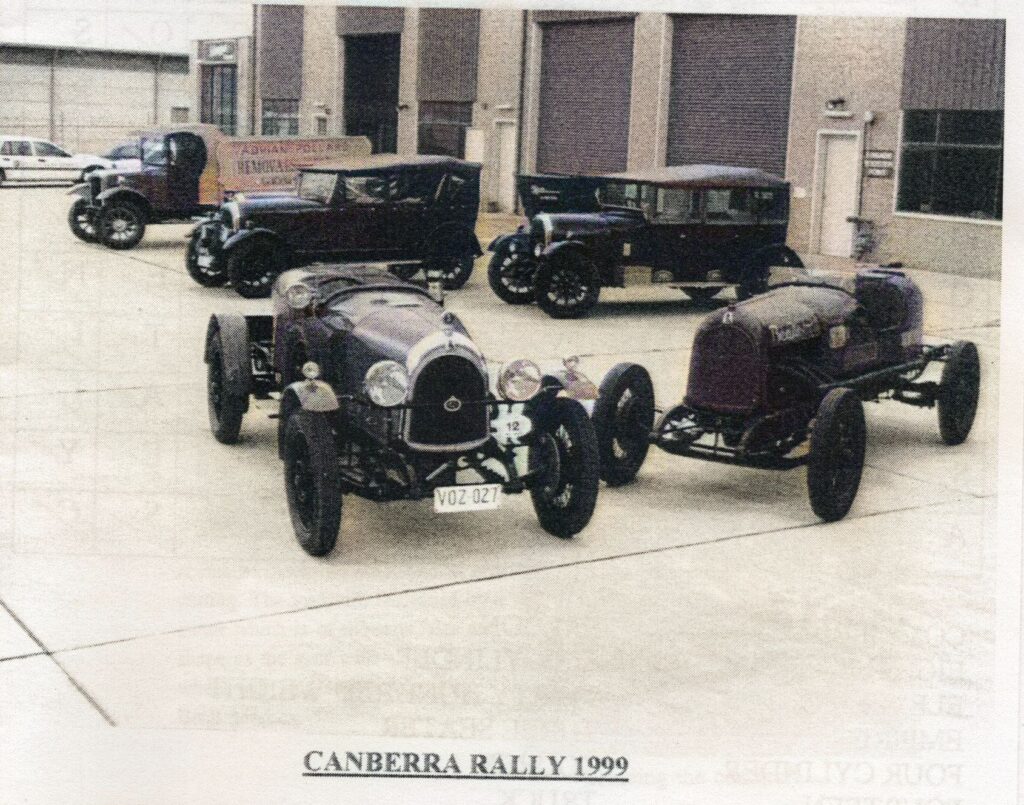
Just a short story from today. Anthony was helping me adjust the clutch pins (a tedious fiddley job) when a bolt dropped into the clutch housing. For over an hour we took it in turns struggling under the dashboard while laying upside down with a magnet on a wire trying to retrieve it and were faced with removing the whole gearbox when all efforts failed.
Anthony had to leave to pick up the kids but upon seeing young Harry he returned to my place. The little bloke rolled his sleeve up, crawled in under the dash and plunging his skinny arm into the bowels of the clutch housing instantly retrieved the bolt.
21 Jan 2024
Well, we are about to be irrevocably committed. The Bean hits the high seas on the 29th. What route it takes to UK is in the lap of the Gods, missiles and hijackers but I suspect it will be the long way around via South Africa. There should be enough time in hand to still meet our Easter departure.
As far as the route is concerned, what I would have considered exciting 30 years ago, is probably not necessary now and the way is open to numerous detours for which we have planning at an advanced state.
As somebody said “We live in interesting times”
And General Eisenhower said “Plans are useless but planning is essential”
Test runs are indicating a smooth, nippy easy driving vehicle but the reality with a 100 year old car is the first breakdown could be before we get out of London. If it was easy everybody would be doing it.
The support from the team in India is really helping. They can claim Birtles for their own motoring history because he was only the second person to drive to India from England and the first solo. More importantly he was the first ever to drive East out of India into South East Asia
2 Feb 2024
Well there is no turning back now. The Bean is in its container to Southampton. Headed for Singapore on the “Cristal Elisabeth” to then be transhipped onto another vessel for England. As mentioned, we are in the lap of the Gods (primarily Woden, Ares or Mars whoever is on duty at the time) as to route and timings so it gets there when it gets there. A quick dart up the Red Sea avoiding Houthi missiles will get us there early or the safe route via South Africa may get us there late. We will depart as soon as it arrives.
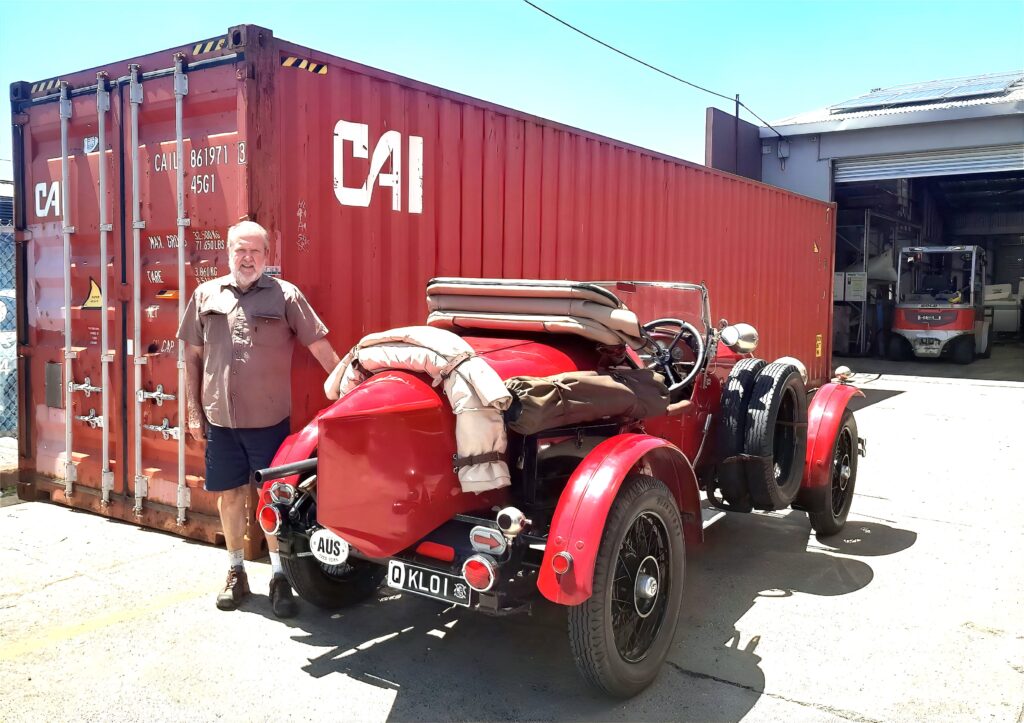
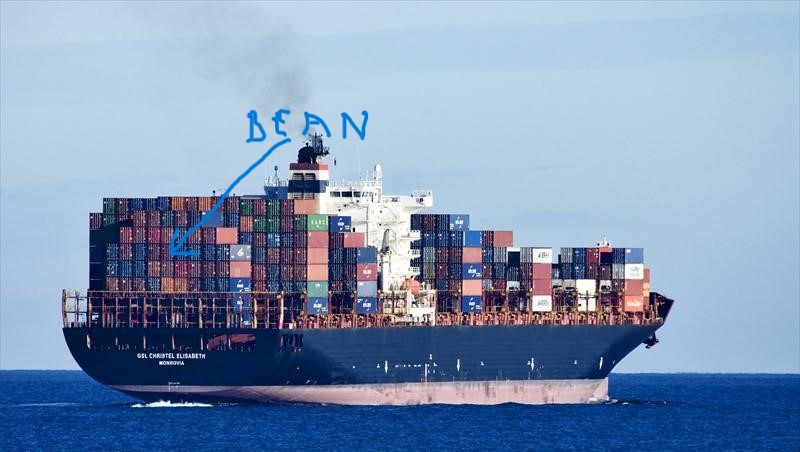
11 February 2024
Here is a nice little segment from the Channel 7 News
https://www.youtube.com/watch?v=K6BJetFzM58
24 February
Here is the progress of the Bean on the high seas as of today.
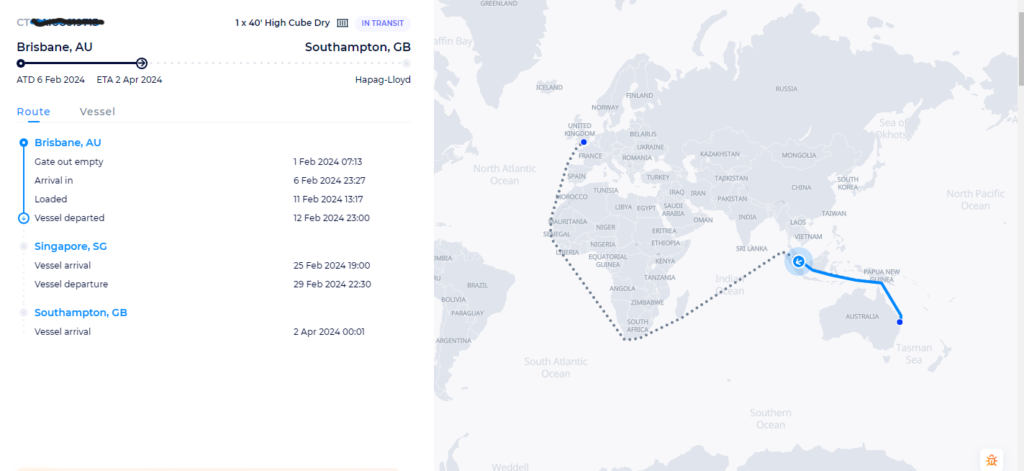
NEW FACEBOOK PAGE
We now have a Facebook page which will be the main medium for our daily enroute reports. It will be getting its first post when the car nears Southampton in a couple of weeks. It is a follow-only page as we will be unable to handle and respond to comments while driving. You may still contact us via email if necessary.
Facebook page name:
Bean 1927 England to Australia Recreation
https://www.facebook.com/profile.php?id=61556943867173
29 February 2024
Visit from Max Ellis
We recently had a visit from Max Ellis, the nephew of M.H. Ellis the leader of several pioneering motoring expeditions. Max has a lot of material from his uncle including his diaries and the two books of trips Ellis and Birtles undertook together. “The Long Haul” about their great expedition across Australia in a standard Bean car, the “Scarlet Runner”, and the wonderful story of their adventures in the Bean 6 , “Scrap Iron”, from England to India in “Express to Hindustan”.
Although Ellis was a highly educated journalist and community leader and Birtles was a rough and hard bushman they both were competent motorists and good friends. He and Francis Birtles did a number of record breaking trips together including the cross-Australia Bean expedition and of course the fantastic effort to drive a failing experimental Bean 6 from England to India in early 1927
Ellis was the great organiser, diplomat and leader while Birtles was the iron man, driving the hardest sections, keeping the car going with endless work, bushman skills and an amazing repertoire of profane language.
The failure of the first England to Australia was a combination of several things. The car had almost totally collapsed (although they could have waited months for new parts), Ellis had a serious foot infection and could not walk and they had run out of money. The official line was the onset of the monsoon season (due to extended delays enroute waiting for parts) making roads impossible.
When Birtles returned to England to collect the old Sundowner to have another try by himself on the Australian trip he had the advantage of all of Ellis’ planning and contacts and of course their combined experience of the Bean 6 trip as far as India 6 months earlier.
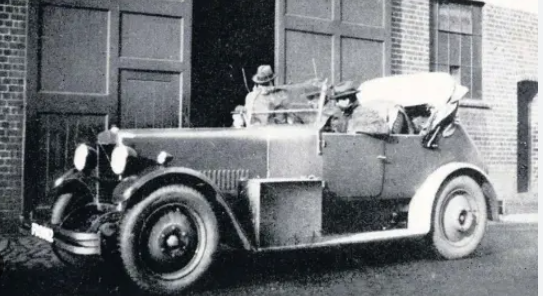
Fortunately for Birtles the section beyond India past the grave of the failed Bean 6 car involved unbelievable hard work (his specialty) and little of the diplomatic border crossing and bureaucratic tangles Ellis ( who spoke several languages) had so patiently dealt with through Europe, the Middle East and Asia.
Turkey was not keen to have him back, a feeling reciprocated by Birtles after their earlier Turkish motoring and bureaucratic adventures. His detour by ship from Greece to Egypt then up through Palestine before getting “back on track” was all through British owned or dominated territory so borders were no problem.
Here are Birtles and Ellis with Simpson the out-of-his-depth engineer, sent from the Bean factory in England, on the Darwin adventure.
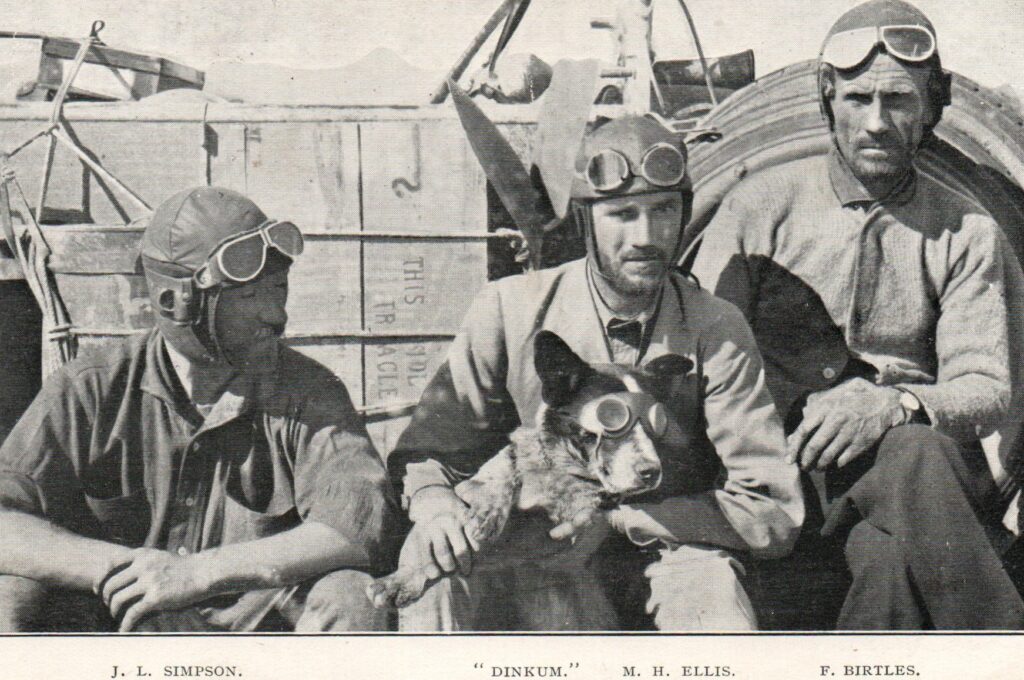
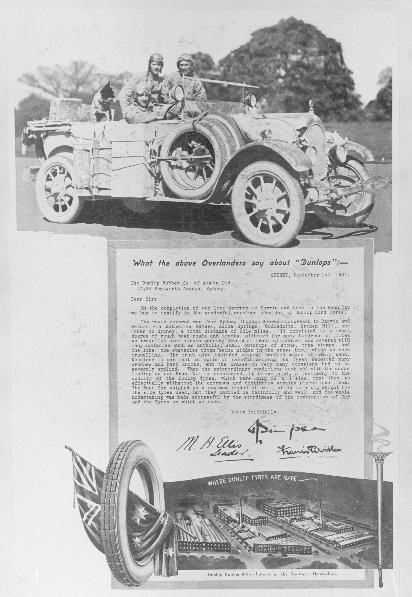
Lang and Max Ellis
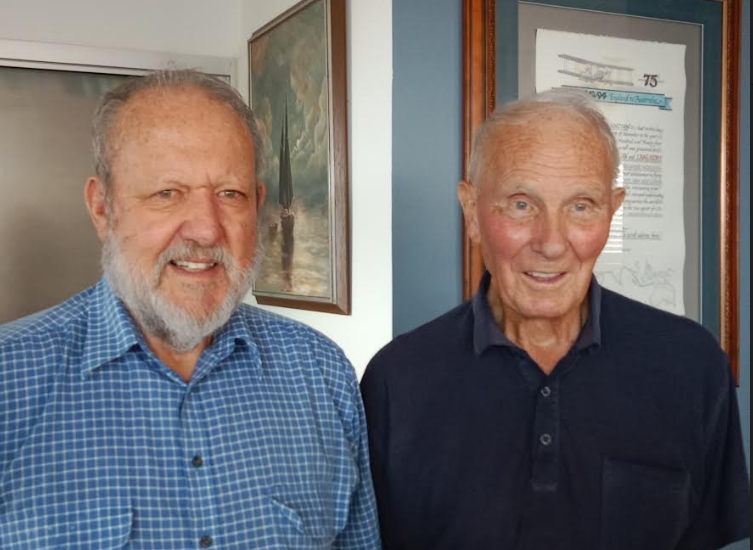
10 March 2024
We have just had a nice compliment by being included in the FIVA Event Calendar with all the famous rallies, shows and concours events across the world. It is something special to be adopted by the world peak body for historic motor vehicles.
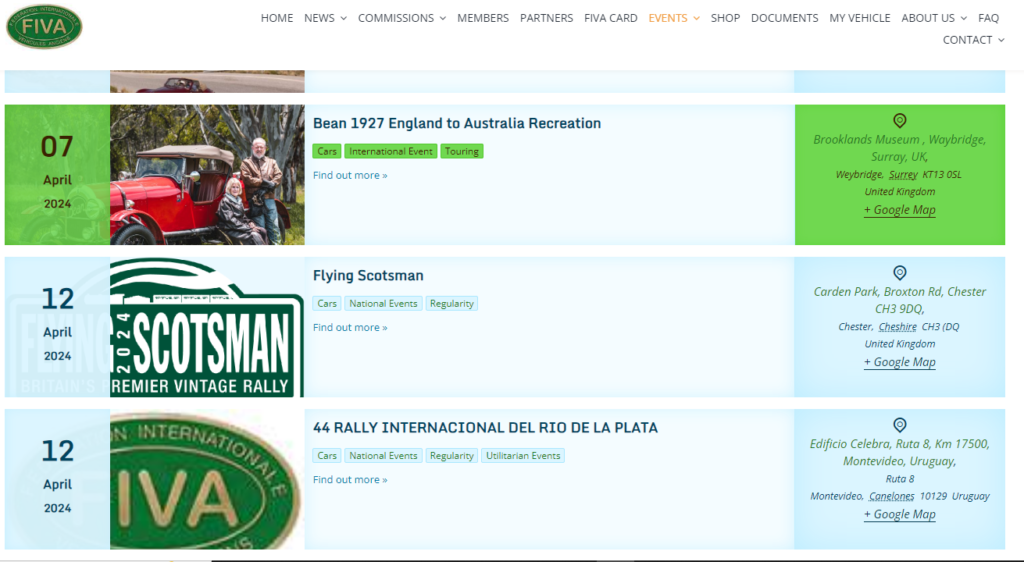
13 March 2024
Today we were presented with a small plaque by well-known Vintage and Veteran car enthusiast. Michael Ferguson. These plaques were carried on the instrument panel of each of Birtles’ many vehicles from 1928 onwards.
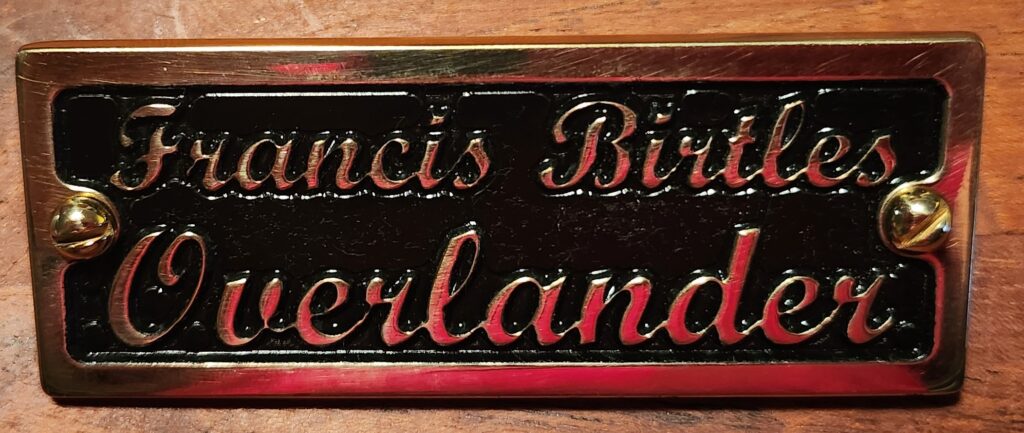
Here is an article on Birtles in one of the most stylish vehicles he ever owned, a really beautiful Wolseley Hornet with a body built in Sydney after the finest French designs of the day. Painted light blue like all his cars during the 30’s (see his Vauxhall Hurlingham above) it carried one of the above plaques.
